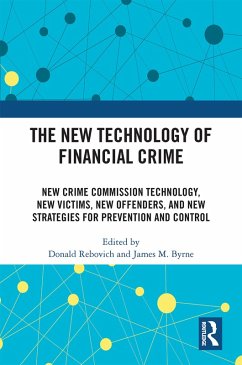The New Technology of Financial Crime (eBook, ePUB)
New Crime Commission Technology, New Victims, New Offenders, and New Strategies for Prevention and Control
Redaktion: Rebovich, Donald; Byrne, James M.
41,95 €
41,95 €
inkl. MwSt.
Sofort per Download lieferbar

21 °P sammeln
41,95 €
Als Download kaufen

41,95 €
inkl. MwSt.
Sofort per Download lieferbar

21 °P sammeln
Jetzt verschenken
Alle Infos zum eBook verschenken
41,95 €
inkl. MwSt.
Sofort per Download lieferbar
Alle Infos zum eBook verschenken

21 °P sammeln
The New Technology of Financial Crime (eBook, ePUB)
New Crime Commission Technology, New Victims, New Offenders, and New Strategies for Prevention and Control
Redaktion: Rebovich, Donald; Byrne, James M.
- Format: ePub
- Merkliste
- Auf die Merkliste
- Bewerten Bewerten
- Teilen
- Produkt teilen
- Produkterinnerung
- Produkterinnerung

Bitte loggen Sie sich zunächst in Ihr Kundenkonto ein oder registrieren Sie sich bei
bücher.de, um das eBook-Abo tolino select nutzen zu können.
Hier können Sie sich einloggen
Hier können Sie sich einloggen
Sie sind bereits eingeloggt. Klicken Sie auf 2. tolino select Abo, um fortzufahren.

Bitte loggen Sie sich zunächst in Ihr Kundenkonto ein oder registrieren Sie sich bei bücher.de, um das eBook-Abo tolino select nutzen zu können.
Financial crime is a trillion-dollar industry that is likely to continue to grow exponentially unless new strategies of prevention and control can be developed. This book covers a wide range of topics related to financial crime commission, victimization, prevention, and control.
- Geräte: eReader
- mit Kopierschutz
- eBook Hilfe
Andere Kunden interessierten sich auch für
![The New Technology of Financial Crime (eBook, PDF) The New Technology of Financial Crime (eBook, PDF)]() The New Technology of Financial Crime (eBook, PDF)41,95 €
The New Technology of Financial Crime (eBook, PDF)41,95 €![The Rise of Politically Motivated Cyber Attacks (eBook, ePUB) The Rise of Politically Motivated Cyber Attacks (eBook, ePUB)]() Tine MunkThe Rise of Politically Motivated Cyber Attacks (eBook, ePUB)43,95 €
Tine MunkThe Rise of Politically Motivated Cyber Attacks (eBook, ePUB)43,95 €![Emerging Technologies, Novel Crimes, and Security (eBook, ePUB) Emerging Technologies, Novel Crimes, and Security (eBook, ePUB)]() Hedi NasheriEmerging Technologies, Novel Crimes, and Security (eBook, ePUB)38,95 €
Hedi NasheriEmerging Technologies, Novel Crimes, and Security (eBook, ePUB)38,95 €![Cybercrime and Digital Deviance (eBook, ePUB) Cybercrime and Digital Deviance (eBook, ePUB)]() Roderick S. GrahamCybercrime and Digital Deviance (eBook, ePUB)39,95 €
Roderick S. GrahamCybercrime and Digital Deviance (eBook, ePUB)39,95 €![Cybersecurity in the COVID-19 Pandemic (eBook, ePUB) Cybersecurity in the COVID-19 Pandemic (eBook, ePUB)]() Kenneth OkereaforCybersecurity in the COVID-19 Pandemic (eBook, ePUB)20,95 €
Kenneth OkereaforCybersecurity in the COVID-19 Pandemic (eBook, ePUB)20,95 €![Digital Piracy (eBook, ePUB) Digital Piracy (eBook, ePUB)]() Digital Piracy (eBook, ePUB)45,95 €
Digital Piracy (eBook, ePUB)45,95 €![The Zero Trust Framework and Privileged Access Management (PAM) (eBook, ePUB) The Zero Trust Framework and Privileged Access Management (PAM) (eBook, ePUB)]() Ravindra DasThe Zero Trust Framework and Privileged Access Management (PAM) (eBook, ePUB)33,95 €
Ravindra DasThe Zero Trust Framework and Privileged Access Management (PAM) (eBook, ePUB)33,95 €-
-
-
Financial crime is a trillion-dollar industry that is likely to continue to grow exponentially unless new strategies of prevention and control can be developed. This book covers a wide range of topics related to financial crime commission, victimization, prevention, and control.
Dieser Download kann aus rechtlichen Gründen nur mit Rechnungsadresse in A, B, BG, CY, CZ, D, DK, EW, E, FIN, F, GR, HR, H, IRL, I, LT, L, LR, M, NL, PL, P, R, S, SLO, SK ausgeliefert werden.
Produktdetails
- Produktdetails
- Verlag: Taylor & Francis eBooks
- Seitenzahl: 252
- Erscheinungstermin: 8. August 2022
- Englisch
- ISBN-13: 9781000630923
- Artikelnr.: 63999330
- Verlag: Taylor & Francis eBooks
- Seitenzahl: 252
- Erscheinungstermin: 8. August 2022
- Englisch
- ISBN-13: 9781000630923
- Artikelnr.: 63999330
- Herstellerkennzeichnung Die Herstellerinformationen sind derzeit nicht verfügbar.
Donald Rebovich, Ph.D., Distinguished Professor of Criminal Justice at Utica College, is the Executive Director of the Center for Identity Management & Information Protection (CIMIP). Prior to coming to Utica College, Dr Rebovich served as Research Director for the National White-Collar Crime Center (NW3C) & the American Prosecutors Research Institute of the National District Attorneys Association (NDAA). James M. Byrne, Ph.D., is a professor in the School of Criminology and Justice Studies at the University of Massachusetts Lowell. He is the Director of the Global Community Corrections Initiative (www.globcci.org) and Editor-in-Chief of the journal, Victims & Offenders. Dr Byrne is the co-editor, The Global Impact of the COVID-19 Pandemic on Institutional and Community Corrections (Routledge, 2021), and is currently completing a new book, The Technology Revolution in Criminal Justice: A Global Review (Routledge, forthcoming).
Introduction 1. The Dynamics of Business, Cybersecurity and
Cyber-Victimization: Foregrounding the Internal Guardian in Prevention 2.
Phishing Evolves: Analyzing the Enduring Cybercrime 3. Online Fraud
Victimization in China: A Case Study of Baidu Tieba 4. Interrelationship
between Bitcoin, Ransomware, and Terrorist Activities: Criminal Opportunity
Assessment via Cyber-Routine Activities Theoretical Framework 5. The Use of
Military Profiles in Romance Fraud Schemes 6. The Distillation of National
Crime Data into A Plan for Elderly Fraud Prevention: A Quantitative and
Qualitative Analysis of U.S. Postal Inspection Service Cases of Fraud
against the Elderly 7. Organized Crime as Financial Crime: The Nature of
Organized Crime as Reflected in Prosecutions and Research 8. Preventing
Identity Theft: Perspectives on Technological Solutions from Industry
Insiders 9. Forecasting Identity Theft Victims: Analyzing Characteristics
and Preventive Actions through Machine Learning Approaches 10. The
Identification of a Model Victim for Social Engineering: A Qualitative
Analysis
Cyber-Victimization: Foregrounding the Internal Guardian in Prevention 2.
Phishing Evolves: Analyzing the Enduring Cybercrime 3. Online Fraud
Victimization in China: A Case Study of Baidu Tieba 4. Interrelationship
between Bitcoin, Ransomware, and Terrorist Activities: Criminal Opportunity
Assessment via Cyber-Routine Activities Theoretical Framework 5. The Use of
Military Profiles in Romance Fraud Schemes 6. The Distillation of National
Crime Data into A Plan for Elderly Fraud Prevention: A Quantitative and
Qualitative Analysis of U.S. Postal Inspection Service Cases of Fraud
against the Elderly 7. Organized Crime as Financial Crime: The Nature of
Organized Crime as Reflected in Prosecutions and Research 8. Preventing
Identity Theft: Perspectives on Technological Solutions from Industry
Insiders 9. Forecasting Identity Theft Victims: Analyzing Characteristics
and Preventive Actions through Machine Learning Approaches 10. The
Identification of a Model Victim for Social Engineering: A Qualitative
Analysis
Introduction 1. The Dynamics of Business, Cybersecurity and
Cyber-Victimization: Foregrounding the Internal Guardian in Prevention 2.
Phishing Evolves: Analyzing the Enduring Cybercrime 3. Online Fraud
Victimization in China: A Case Study of Baidu Tieba 4. Interrelationship
between Bitcoin, Ransomware, and Terrorist Activities: Criminal Opportunity
Assessment via Cyber-Routine Activities Theoretical Framework 5. The Use of
Military Profiles in Romance Fraud Schemes 6. The Distillation of National
Crime Data into A Plan for Elderly Fraud Prevention: A Quantitative and
Qualitative Analysis of U.S. Postal Inspection Service Cases of Fraud
against the Elderly 7. Organized Crime as Financial Crime: The Nature of
Organized Crime as Reflected in Prosecutions and Research 8. Preventing
Identity Theft: Perspectives on Technological Solutions from Industry
Insiders 9. Forecasting Identity Theft Victims: Analyzing Characteristics
and Preventive Actions through Machine Learning Approaches 10. The
Identification of a Model Victim for Social Engineering: A Qualitative
Analysis
Cyber-Victimization: Foregrounding the Internal Guardian in Prevention 2.
Phishing Evolves: Analyzing the Enduring Cybercrime 3. Online Fraud
Victimization in China: A Case Study of Baidu Tieba 4. Interrelationship
between Bitcoin, Ransomware, and Terrorist Activities: Criminal Opportunity
Assessment via Cyber-Routine Activities Theoretical Framework 5. The Use of
Military Profiles in Romance Fraud Schemes 6. The Distillation of National
Crime Data into A Plan for Elderly Fraud Prevention: A Quantitative and
Qualitative Analysis of U.S. Postal Inspection Service Cases of Fraud
against the Elderly 7. Organized Crime as Financial Crime: The Nature of
Organized Crime as Reflected in Prosecutions and Research 8. Preventing
Identity Theft: Perspectives on Technological Solutions from Industry
Insiders 9. Forecasting Identity Theft Victims: Analyzing Characteristics
and Preventive Actions through Machine Learning Approaches 10. The
Identification of a Model Victim for Social Engineering: A Qualitative
Analysis







